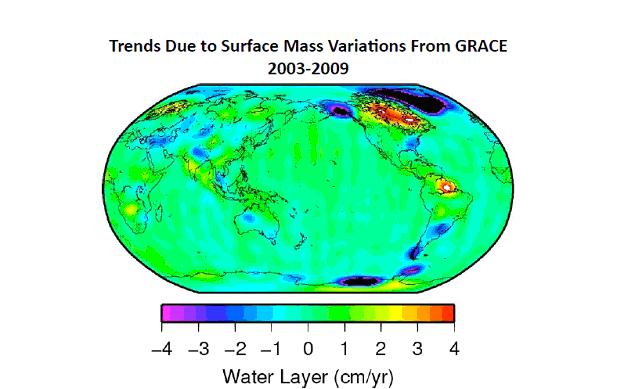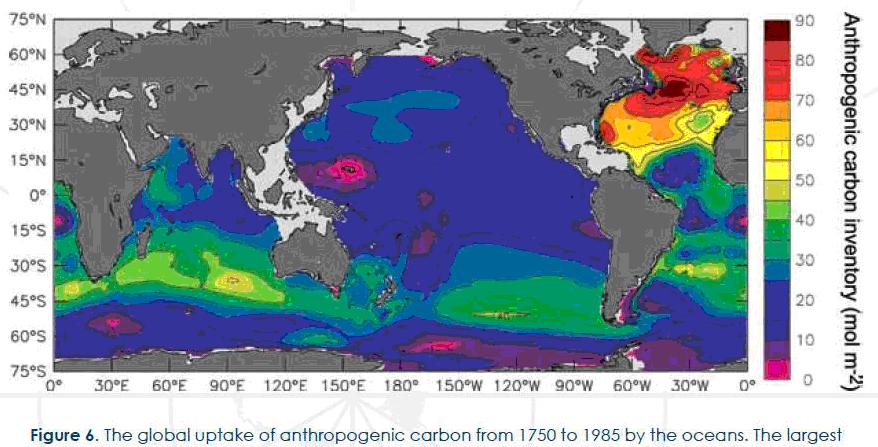That question has been nagging me since I did, when I looked at the following visual at last week's CERES 2012 Conference, "Igniting Innovation, Scaling Sustainability."

This is an image, derived from a pair of NASA satellites named "Grace",
that shows the cumulative increase (red-green) or decrease in the
amount of water on each part of the earth's surface from 2003-2009. You
can actually see how the climate has changed, with the blue regions
getting drier, and the red ones wetter.
As Dr. Jay Famiglietta of UC Irvine,
who flashed this image in front of us, put it, we are producing more
rain, more evaporation, more stream flow -- and overall draining the
continents of the water which makes ecosystems and civilization
flourish. And unlike the weather, which is highly variable anyway,
these water trends build up more slowly, even through wet and dry years,
so we can easily tell that, yes, things are getting worse.
This shouldn't be surprising. Storing heat in the atmosphere (aka
global warming) means there is more energy in the climate system. Just
as a saucepan at a rolling boil is more violent than one at a simmer, so
our climate at 450 ppm CO2 will be more violent than it was at 225 ppm
-- because CO2 stores heat, just like putting a lid on a saucepan brings
it to a much higher boil.
But climate scientists -- in the interest of knowledge -- tried to
explain to us how they measured this phenomenon, with their complex
computer models -- rather than pointing us to the easier to measure
cumulative results of messing with atmospheric chemistry.
The other obvious missed opportunity to rebut the cynical effort by
the carbon lobby to keep the public from recognizing the clear and
present danger posed by carbon pollution was a sufficient focus on ocean
acidity. Here there is no dubious climate science, no doubters. More
atmospheric CO2 = more acidic oceans. And you can measure the
cumulative impact:

The Heartland Institute, one of the more prominent and heavy-handed climate cynics, does claim that ocean acidification will be good for the oceans, making them "less basic" rather than "more acid." Heartland quotes its allies as claiming that "the net impact of twentieth century increases in atmospheric CO2 and temperature has not been anywhere near as catastrophically disruptive to Earth's marine organisms" as marine biologists are worried about. But note the weasel words: "anywhere near as catastrophically disruptive" is a far cry from, "no impact." More typically, another global warming cynic site tries to obscure the cumulative increase in ocean acidity by saying, well there are variable cycles all the time, so it can't matter. "Some marine life can live through larger, faster swings than the apocalyptic predictions suggest, though of course, no one is suggesting that the entire global ocean would be happy with similar extreme swings." Reassured?
While the carbon lobby will always, always claim that climate change
is not really so bad, that's not what is lulling the public -- it's the
uncertainty about whether it is already happening, which GRACE shows us
clearly it is, and whether man-made emissions are the cause, which the
ocean acidification data demonstrates beyond a doubt.
Compare the visual impact of the GRACE photo with the following, important but hard to track report in Monday's New York Times,
on the fact that the remaining major uncertainty being exploited by
climate cynics is the real uncertainty about exactly how clouds might
make climate change happen faster or more slowly. "The scientific
majority believes that clouds will most likely have a neutral effect or
will even amplify the warming, perhaps strongly, but the lack of
unambiguous proof has left room for dissent." This is true -- and
taken in isolation, many readers might feel less concern reading it than
they felt when they opened the paper. But in fact, this statement is
not reassuring al all -- since even if, like climate cynics, you don't
believe we can model climate very well, it is still equally likely that
clouds will make things worse than that they will help us out. But
without a visual to drive it home, without being able to see it, this
story, like most on temperature variability, doesn't have the punch of a
good picture -- like the one I saw at the CERES conference a few days
ago.
Maybe we can move public understanding along better if we spend less
energy on debating the climate models, and the temperature variability,
and more on the things -- like more energetic water flows, resulting in
the overall drying out of the continents by the climate system, or more
acid being absorbed in the ocean -- that increase gradually, over time,
but whose dimensions are much harder to debate.
No comments:
Post a Comment